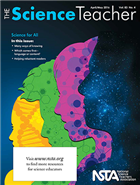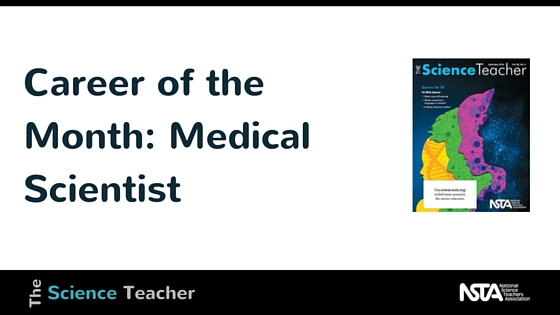Career of the Month: Medical Scientist
By sstuckey
Posted on 2016-04-25
Based on Interviews With Professionals Using Science in the Workplace
Medical scientists conduct laboratory experiments to try to find answers to difficult medical problems while also applying their knowledge to treat patients in a clinical setting. Brian Brooks is an ophthalmologist who specializes in vision problems associated with coloboma and albinism. He is chief of the Unit of Genetic and Developmental Eye Disease at the National Eye Institute, which is part of the National Institutes of Health (NIH) in Bethesda, Maryland.
Work Overview
I do lab work to understand how children and adults go blind and determine how to treat their eye diseases. Coloboma is a rare disorder that can cause children to have keyhole-shaped pupils and that can block signals from the retina and optic nerve to the brain and cause blindness. We don’t know why it occurs or if it can be prevented. To look for underlying genetic causes for the disease, we examine patients and their first-degree relatives and sequence their genes. Everyone has mutations, or “misspellings” in their genetic code. We try to separate the disease-causing misspellings from the benign ones that we all carry.
It’s difficult to figure out cause and effect. If our research team can locate a genetic misspelling, we can try to predict whether it is harmful to that gene. We know we’re on the right track if we start to see the same pattern in more than one unrelated family. We also look at the effects of changing the genetics of mice and zebrafish. Mice are mammals like us, and their genetics are particularly well understood, whereas zebrafish develop very fast, and their eyes are transparent when they are young. So we use the fish to test our hypotheses, to see which ones are worth further testing in mice or in a cell culture. The work involves a lot of data crunching.
I’m also researching potential treatments for albinism, a condition that leads to abnormalities in vision development due to reduced melanin. If the condition can be identified at birth and treated, it might improve the person’s vision. We first looked at drugs used to treat other conditions. We then tested a drug called NTBC that might interact with the body’s melanin-production pathway in mice with albinism and also in cell cultures. It corrected some features of albinism in the mice. Now, we have permission to conduct a pilot study in five adults with this particular type of albinism to see whether it affects their melanin levels.
Career Highlights
I went to the White House to receive a Presidential Early Career Award in Science and Engineering a few years ago. Another highlight was receiving tenure at the National Eye Institute.
Career Path
I started in electrical engineering at the University of Maryland, but I also took several biology and chemistry courses. I soon realized that I was more interested in using engineering as a tool in biology and switched my major to biochemistry.
What I found most appealing was the intersection of science and medicine, so I went on to get a combined MD and PhD degree. I decided to specialize in ophthalmology, a field with many unanswered questions. Blindness exists in many forms, and for many of them there are no good treatments.
I did my residency in ophthalmology with a subspecialty in pediatric ophthalmology at the University of Michigan. Then I got a fellowship to work on medical genetics at the NIH. When the fellowship ended, I stayed on as a staff member at the NIH.
Knowledge, Skills, and Training Needed
You should be inquisitive, because you have to combine elements from different areas of science and engineering to accomplish goals. Be patient, because not all hypotheses lead to results. Also, become good at writing and public speaking, because if you can’t communicate your findings effectively, your work will be hard to understand.
Advice for Students
The only thing that will keep you going is a love for science and medicine. It’s very helpful to take basic science, computer science, and some engineering courses. Also try to get some lab experience. Every step of the way, work on your ability to communicate your understanding of science to others, either by taking writing classes or by taking science classes that require writing or giving presentations.
Bonus Points
Brooks’s education:
BS in biochemistry from the University of Maryland; MD and PhD in biochemistry from the University of Pennsylvania.
On the web:
http://irp.nih.gov/pi/brian-brooks
Related occupations:
Optometrist, orthoptist, nurse, genetic counselor, biologist, and lab technician.
Editor’s Note
This article was originally published in the April/May 2016 issue of The Science Teacher journal from the National Science Teachers Association (NSTA).
Get Involved With NSTA!
 Join NSTA today and receive The Science Teacher, the peer-reviewed journal just for high school teachers; to write for the journal, see our Author Guidelines and Call for Papers; connect on the high school level science teaching list (members can sign up on the list server); or consider joining your peers at future NSTA conferences.
Join NSTA today and receive The Science Teacher, the peer-reviewed journal just for high school teachers; to write for the journal, see our Author Guidelines and Call for Papers; connect on the high school level science teaching list (members can sign up on the list server); or consider joining your peers at future NSTA conferences.
The mission of NSTA is to promote excellence and innovation in science teaching and learning for all.
Future NSTA Conferences
5th Annual STEM Forum & Expo, hosted by NSTA
- Denver, Colorado: July 27–29
2017
Area Conferences
- Baltimore, Maryland: October 5–7
- Milwaukee, Wisconsin: November 9–11
- New Orleans, Louisiana: November 30–December 2
National Conferences
- Los Angeles, California: March 30–April 2, 2017
- Atlanta, Georgia: March 15–18, 2018
- St. Louis, Missouri: April 11–14, 2019
- Boston, Massachusetts: March 26–29, 2020
- Chicago, Illinois: April 8–11, 2021
Follow NSTA
Disclaimer: The views expressed in this blog post are those of the author(s) and do not necessarily reflect the official position of the National Science Teaching Association (NSTA).





